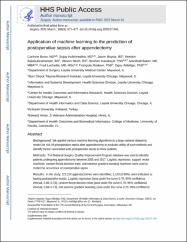| dc.contributor.author | Bunn, Corinne | |
| dc.contributor.author | Kulshrestha, Sujay | |
| dc.contributor.author | Boyda, Jason | |
| dc.contributor.author | Balasubramanian, Neelam | |
| dc.contributor.author | Birch, Steven | |
| dc.contributor.author | Karabayır, İbrahim | |
| dc.contributor.author | Akbilgiç, Oğuz | |
| dc.date.accessioned | 2021-12-12T17:03:34Z | |
| dc.date.available | 2021-12-12T17:03:34Z | |
| dc.date.issued | 2021 | |
| dc.identifier.issn | 0039-6060 | |
| dc.identifier.uri | https://doi.org/10.1016/j.surg.2020.07.045 | |
| dc.identifier.uri | https://hdl.handle.net/20.500.11857/3701 | |
| dc.description.abstract | Background: We applied various machine learning algorithms to a large national dataset to model the risk of postoperative sepsis after appendectomy to evaluate utility of such methods and identify factors associated with postoperative sepsis in these patients. Methods: The National Surgery Quality Improvement Program database was used to identify patients undergoing appendectomy between 2005 and 2017. Logistic regression, support vector machines, random forest decision trees, and extreme gradient boosting machines were used to model the occurrence of postoperative sepsis. Results: In the study, 223,214 appendectomies were identified; 2,143 (0.96%) were indicated as having postoperative sepsis. Logistic regression (area under the curve 0.70; 95% confidence interval, 0.68-0.73), random forest decision trees (area under the curve 0.70; 95% confidence interval, 0.68-0.73), and extreme gradient boosting (area under the curve 0.70; 95% confidence interval, 0.68-0.73) afforded similar performance, while support vector machines (area under the curve 0.51; 95% confidence interval, 0.50-0.52) had worse performance. Variable importance analyses identified preoperative congestive heart failure, transfusion, and acute renal failure as predictors of postoperative sepsis. Conclusion: Machine learning methods can be used to predict the development of sepsis after appendectomy with moderate accuracy. Such predictive modeling has potential to ultimately allow for preoperative recognition of patients at risk for developing postoperative sepsis after appendectomy thus facilitating early intervention and reducing morbidity. (c) 2020 Elsevier Inc. All rights reserved. | en_US |
| dc.description.sponsorship | National Institute of Health T32 NIGMS [5T32GM008750-20]; National Institute of Health T32 NIAAA [5T32AA013527-17] | en_US |
| dc.description.sponsorship | Dr C. Bunn is supported by National Institute of Health T32 NIGMS 5T32GM008750-20. Dr S. Kulshrestha is supported by National Institute of Health T32 NIAAA 5T32AA013527-17. | en_US |
| dc.language.iso | eng | en_US |
| dc.publisher | Mosby-Elsevier | en_US |
| dc.relation.ispartof | Surgery | en_US |
| dc.identifier.doi | 10.1016/j.surg.2020.07.045 | |
| dc.rights | info:eu-repo/semantics/closedAccess | en_US |
| dc.subject | [No Keywords] | en_US |
| dc.title | Application of machine learning to the prediction of postoperative sepsis after appendectomy | en_US |
| dc.type | article | |
| dc.authorid | Karabayir, Ibrahim/0000-0002-7928-176X | |
| dc.authorid | Kulshrestha, Sujay/0000-0002-2074-4010 | |
| dc.authorid | akbilgic, oguz/0000-0003-0313-9254 | |
| dc.authorid | Birch, Steven/0000-0001-8610-7690 | |
| dc.department | Fakülteler, İktisadi ve İdari Bilimler Fakültesi, Ekonometri Bölümü | |
| dc.identifier.volume | 169 | en_US |
| dc.identifier.startpage | 671 | en_US |
| dc.identifier.issue | 3 | en_US |
| dc.identifier.endpage | 677 | en_US |
| dc.relation.publicationcategory | Makale - Uluslararası Hakemli Dergi - Kurum Öğretim Elemanı | en_US |
| dc.authorscopusid | 57217287477 | |
| dc.authorscopusid | 57216852800 | |
| dc.authorscopusid | 57211262550 | |
| dc.authorscopusid | 57189363730 | |
| dc.authorscopusid | 57206543828 | |
| dc.authorscopusid | 56677890800 | |
| dc.authorscopusid | 36865330200 | |
| dc.identifier.wos | WOS:000616586400031 | en_US |
| dc.identifier.scopus | 2-s2.0-85091249604 | en_US |
| dc.identifier.pmid | PubMed: 32951903 | en_US |
| dc.authorwosid | Karabayir, Ibrahim/AAC-3262-2019 | |
| dc.authorwosid | akbilgic, oguz/F-9407-2013 | |



















